821 items found
Page 1 of 9
-

The environs of London in 1746. Impressive sixteen sheet set.
£4,500 the set of sixteen sheetsThe environs of London in 1746. Impressive sixteen sheet set.
John Rocque was of French Huguenot stock from Monosque in Provence. The London he eventually settled in, was an expanding city which had grown unchecked and by the 1730s a new map was needed. Harry Margary, a Senior Civil Scientific Engineer for the Admiralty and self-professed inventor, produced this full-size facsimile of the famous John Rocque map in 1971. The original 18th century map never joined properly due to paper shrinkage in the printing process and only the constituent copper plates joined. For this lithographically printed version Margary altered some of the edges so the maps would join and significantly cleaned up the image area.£4,500 the set of sixteen sheets -
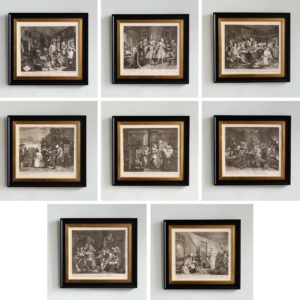
A Rake’s Progress after William Hogarth. A set of eight copper-engraved prints
£2,800 the set of eightA Rake’s Progress after William Hogarth. A set of eight copper-engraved prints
1803 Thomas Cook edition. Framed in black with a gold slip.£2,800 the set of eight -
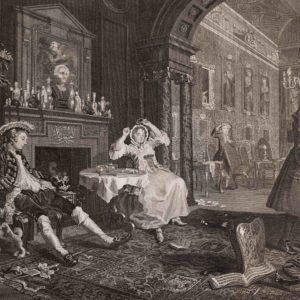
Marriage-a-la Mode, after William Hogarth. A set of six copper-engraved prints
£2,200 the set of sixMarriage-a-la Mode, after William Hogarth. A set of six copper-engraved prints
1803 Thomas Cook edition. Framed in black with a gold slip.£2,200 the set of six -

Henri Matisse, Nu Bleu I
£1,750 eachHenri Matisse, Nu Bleu I
The foreword states: 'This double number of Verve is entirely dedicated to the last works of Matisse - 1950-1954. Reproduced in colour lithography, these works have been realised by the artist with papers coloured in gouache, cut with scissors and pasted. They are shown here with drawings executed at the same time or during the preceding period. Matisse composed the cover specially for this volume. These first lithographic plates were printed during the year 1954 under his direction. The printing of the lithographs in colour by Mourlot Frères and that of the photogravure reproductions and the typography by the master printers Draeger Frères, was completed in Paris on the 28th day of July 1958.'£1,750 each -

Henri Matisse, Nu Bleu II
£1,750 eachHenri Matisse, Nu Bleu II
The foreword states: 'This double number of Verve is entirely dedicated to the last works of Matisse - 1950-1954. Reproduced in colour lithography, these works have been realised by the artist with papers coloured in gouache, cut with scissors and pasted. They are shown here with drawings executed at the same time or during the preceding period. Matisse composed the cover specially for this volume. These first lithographic plates were printed during the year 1954 under his direction. The printing of the lithographs in colour by Mourlot Frères and that of the photogravure reproductions and the typography by the master printers Draeger Frères, was completed in Paris on the 28th day of July 1958.'£1,750 each -

Henri Matisse, Nu Bleu IV
£1,750 eachHenri Matisse, Nu Bleu IV
The foreword states: 'This double number of Verve is entirely dedicated to the last works of Matisse - 1950-1954. Reproduced in colour lithography, these works have been realised by the artist with papers coloured in gouache, cut with scissors and pasted. They are shown here with drawings executed at the same time or during the preceding period. Matisse composed the cover specially for this volume. These first lithographic plates were printed during the year 1954 under his direction. The printing of the lithographs in colour by Mourlot Frères and that of the photogravure reproductions and the typography by the master printers Draeger Frères, was completed in Paris on the 28th day of July 1958.'£1,750 each -

Henri Matisse, Nu Bleu X
£1,750 eachHenri Matisse, Nu Bleu X
The foreword states: 'This double number of Verve is entirely dedicated to the last works of Matisse - 1950-1954. Reproduced in colour lithography, these works have been realised by the artist with papers coloured in gouache, cut with scissors and pasted. They are shown here with drawings executed at the same time or during the preceding period. Matisse composed the cover specially for this volume. These first lithographic plates were printed during the year 1954 under his direction. The printing of the lithographs in colour by Mourlot Frères and that of the photogravure reproductions and the typography by the master printers Draeger Frères, was completed in Paris on the 28th day of July 1958.'£1,750 each -

Henri Matisse, Nu Bleu V
£1,750 eachHenri Matisse, Nu Bleu V
The foreword states: 'This double number of Verve is entirely dedicated to the last works of Matisse - 1950-1954. Reproduced in colour lithography, these works have been realised by the artist with papers coloured in gouache, cut with scissors and pasted. They are shown here with drawings executed at the same time or during the preceding period. Matisse composed the cover specially for this volume. These first lithographic plates were printed during the year 1954 under his direction. The printing of the lithographs in colour by Mourlot Frères and that of the photogravure reproductions and the typography by the master printers Draeger Frères, was completed in Paris on the 28th day of July 1958.'£1,750 each -

Henri Matisse, Nu Bleu VIII
£1,750 eachHenri Matisse, Nu Bleu VIII
The foreword states: 'This double number of Verve is entirely dedicated to the last works of Matisse - 1950-1954. Reproduced in colour lithography, these works have been realised by the artist with papers coloured in gouache, cut with scissors and pasted. They are shown here with drawings executed at the same time or during the preceding period. Matisse composed the cover specially for this volume. These first lithographic plates were printed during the year 1954 under his direction. The printing of the lithographs in colour by Mourlot Frères and that of the photogravure reproductions and the typography by the master printers Draeger Frères, was completed in Paris on the 28th day of July 1958.'£1,750 each -

A set of 12 “Cries of London” framed hand-coloured engravings
£1,550 the setA set of 12 “Cries of London” framed hand-coloured engravings
each hand-coloured engraving, depicting a street-seller plying their wares, presented in Verre Eglomise frames, [Condition: the prints, faded, foxed and browned in places, the frames with losses and flaking to the Verre Eglomise]£1,550 the set -
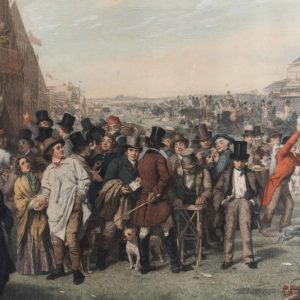
William Powell Frith ‘The Derby Day’
£1,450 -

Eagle Wharf, Whistler
£1,200Eagle Wharf, Whistler
A framed black-line etching by the American artist and engraver James MacNeil Whistler showing shipping off Eagle Wharf off Wapping in the Pool of London. Taken from 'A Series of Sixteen Etchings of Scenes on the Thames and Other Subjects', otherwise referred to as The Thames Set, the pictures were created over a period of 12 years starting in 1859 and finally published as a complete set by Ellis & Green in London in 1871.£1,200 -

The Dance, by Henri Matisse, Jan – March 1939 / No. 4.
£1,200The Dance, by Henri Matisse, Jan – March 1939 / No. 4.
The Verve Review was a purposefully luxurious. It ran from 1937 to 1960, but with only 38 editions available, due to the high degree of design and editorial work dedicated to each issue. Each edition contained unique lithographic prints, commissioned by the editor, and each cover a double-page lithograph elaborated by one of the artists contained within. It was the brainchild of its editor Stratis Eleftheriades, a Greek National who moved to Paris in the early thirties to take part in the growing Modernist movement, writing under the name of Teriade.£1,200 -

Philips’ A Map of Europe To Illustrate The Territorial Changes Since 1914
£1,200Philips’ A Map of Europe To Illustrate The Territorial Changes Since 1914
The Royal Geographical Society was founded in 1830 as an institution to promote the 'advancement of geographical science'.£1,200 -
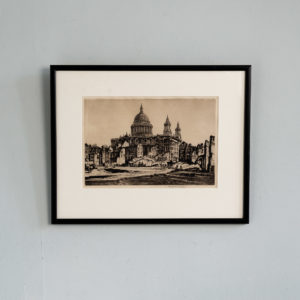
Henry Rushbury, St. Pauls from the North,
£1,200Henry Rushbury, St. Pauls from the North,
A signed and dated, framed and mounted drypoint engraving by Sir Henry Rushbury showing St Pauls Cathedral viewed over the bomb damaged remnant of what was Paternoster Row and London's printing district after the 'Worst Raid' of the London Blitz on the 10-11th of May 1941. First exhibited at the Royal Academy, Summer Exhibition in 1944, the print is one of a series by Sir Henry documenting the destruction of London landmarks during the Second World War.£1,200 -

The Collector by Dan Hillier (1973-2024)
£950The Collector by Dan Hillier (1973-2024)
Dan Hillier captured the zeitgeist of the early noughties with his collages that combined Victorian source materials with human, animal, and arcane elements into mysterious surreal art works. Born in Oxfordshire he went on to study Illustration and Graphic Arts at Anglia Ruskin University in Cambridge, later living and working in Stoke Newington, London. Beginning to sell his prints from a market stall in East London he eventually attracting the attention of prestigious gallerists and commercial collaborators like Shakespeare’s Globe, Marc Jacobs, Louis Vuitton and the National Theatre. Dan's distinctive art graced the opening titles of the 2018 BBC drama series Requiem. He moved to Dartmoor in 2022 to be closer to his family and nature but sadly, Dan Hillier passed away in 2024 following a short illness.£950 -

Henri Matisse, ‘The Last Works of Henri Matisse’
£900 eachHenri Matisse, ‘The Last Works of Henri Matisse’
From Verve Vol. IX No. 35/36 published by Tériade under the title 'The Last Works of Henri Matisse'£900 each -

Ramsgate Sands by William Powell Frith
£900Ramsgate Sands by William Powell Frith
Original steel engraving published 1854. Presented in a gilt frame with lower margin title, trimmed to the image area£900 -

The Strand, William Walcot
£850The Strand, William Walcot
Framed and mounted black line etching by the artist-engraver William Walcot showing the The Strand during the construction of the Aldwych in 1924. Issued as part of Walcot's London Set at the height of his success.£850 -

The Army and Navy Nelson & Wellington,
£850The Army and Navy Nelson & Wellington,
A hand coloured engraving By S.W. Reynolds after a painting by John Prescott Knight showing the only meeting between Arthur Wellesley Duke of Wellington and Admiral Lord Horatio Nelson, which took place in September, 1805 at the Colonial Office on Downing Street in London.£850 -

A General Prospect of Vaux Hall Gardens. Shewing at one View the disposition of the whole Gardens. Vüe Détaillee des Jardins de Vaux Hall.
£850A General Prospect of Vaux Hall Gardens. Shewing at one View the disposition of the whole Gardens. Vüe Détaillee des Jardins de Vaux Hall.
Originally engraved by William Simpkins (fl.1784-1825) for Owen Manning and William Bray’s “History and Antiquities of Surrey” (1804-1814).£850 -

W. L Wylie R. A., Old Waterloo Bridge from the South Bank,
£850W. L Wylie R. A., Old Waterloo Bridge from the South Bank,
An original dry-point engraving by British marine artist, painter etcher and illustrator W. L. Wyllie (1851-1931) showing Old Waterloo Bridge from the Surrey shore with three steam Toshers working on the Lambeth Reach of the River Thames. Mounted and in its original frame. Old Waterloo bridge, designed and built by the engineer John Rennie was built in 1827 and stood until 1924 when the increased scour of the river, caused by the removal of the many-piered Old London Bridge, made necessary its dismantling and replacement. Signed by the artist in pencil in he margin.£850 -

W. L Wylie R. A., Sugar boats Greenwich Reach,
£850W. L Wylie R. A., Sugar boats Greenwich Reach,
An original dry-point engraving by British marine artist, painter etcher and illustrator W. L. Wyllie (1851-1931). Signed in pencil by the artist "A view of Greenwich from the Isle of Dogs (i.e. the north-west) with figures, probably local boys, swimming off the beach in the foreground around a small lighter. The Royal Naval College is to the left and the Royal Observatory high in the background above the Park and the riverside town centre of Greenwich proper. In the centre cargo ships are unloading sugar into lighters alongside, in the deep-water mooring tier between Greenwich and Deptford. The atmosphere beyond over the shoreline is one of industrial haze through which a Thames barge, chimneys and a crane can be seen. Astern of the ships small steamers cluster off Greenwich Pier." National Maritime Museum listing.£850 -
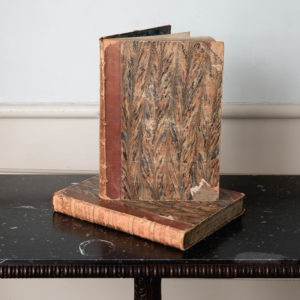
Picturesque Views on the River Thames by Samuel Ireland, 1792
£850Picturesque Views on the River Thames by Samuel Ireland, 1792
2 Volumes of 209 and 258 pages with 52 aquatint plates picturing views along the river Thames including Blenheim Castle, Windsor Castle, London bridges, Westminster Abbey, and The Royal Naval Hospital at Greenwich. Original half calf, marbled binding of 1792, rubbed and worn with faint spotting. Samuel Ireland produced a series of these scenic views of British rivers at the end of the 18th Century as the fear of French invasion prompted a national turn towards patriotic and contemplative representations of domestic subjects.£850 -

The Reconstruction of Piccadilly, William Walcot
£840The Reconstruction of Piccadilly, William Walcot
Framed and mounted black line etching by the artist-engraver William Walcot showing the rebuilding of Picadilly Circus and the Swan and Edgar building following destruction by Zeppelin raid in 1917. Issued as part of Walcot's London Set in 1924.£840 -

Portrait by Andre Derain, Verve Vol 2 / No. 5-6.
£800Portrait by Andre Derain, Verve Vol 2 / No. 5-6.
The Verve Review was a purposefully luxurious. It ran from 1937 to 1960, but with only 38 editions available, due to the high degree of design and editorial work dedicated to each issue. Each edition contained unique lithographic prints, commissioned by the editor, and each cover a double-page lithograph elaborated by one of the artists contained within. It was the brainchild of its editor Stratis Eleftheriades, a Greek National who moved to Paris in the early thirties to take part in the growing Modernist movement, writing under the name of Teriade.£800 -

Head of a Girl by George Rouault, Verve Vol 2 / No. 5-6.
£800Head of a Girl by George Rouault, Verve Vol 2 / No. 5-6.
The Verve Review was a purposefully luxurious. It ran from 1937 to 1960, but with only 38 editions available, due to the high degree of design and editorial work dedicated to each issue. Each edition contained unique lithographic prints, commissioned by the editor, and each cover a double-page lithograph elaborated by one of the artists contained within. It was the brainchild of its editor Stratis Eleftheriades, a Greek National who moved to Paris in the early thirties to take part in the growing Modernist movement, writing under the name of Teriade.£800 -

Stars by Wassily Kandinsky, Verve Vol. 1 / No. 2.
£800Stars by Wassily Kandinsky, Verve Vol. 1 / No. 2.
The Verve Review was a purposefully luxurious. It ran from 1937 to 1960, but with only 38 editions available, due to the high degree of design and editorial work dedicated to each issue. Each edition contained unique lithographic prints, commissioned by the editor, and each cover a double-page lithograph elaborated by one of the artists contained within. It was the brainchild of its editor Stratis Eleftheriades, a Greek National who moved to Paris in the early thirties to take part in the growing Modernist movement, writing under the name of Teriade.£800 -

Comets by Wassily Kandinsky, Verve Vol. 1 / No. 2.
£800Comets by Wassily Kandinsky, Verve Vol. 1 / No. 2.
The Verve Review was a purposefully luxurious. It ran from 1937 to 1960, but with only 38 editions available, due to the high degree of design and editorial work dedicated to each issue. Each edition contained unique lithographic prints, commissioned by the editor, and each cover a double-page lithograph elaborated by one of the artists contained within. It was the brainchild of its editor Stratis Eleftheriades, a Greek National who moved to Paris in the early thirties to take part in the growing Modernist movement, writing under the name of Teriade.£800 -
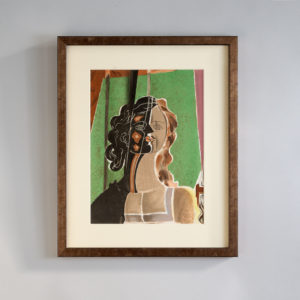
Figure by Georges Braque, Verve Vol 2 / No. 5-6.
£800Figure by Georges Braque, Verve Vol 2 / No. 5-6.
The Verve Review was a purposefully luxurious. It ran from 1937 to 1960, but with only 38 editions available, due to the high degree of design and editorial work dedicated to each issue. Each edition contained unique lithographic prints, commissioned by the editor, and each cover a double-page lithograph elaborated by one of the artists contained within. It was the brainchild of its editor Stratis Eleftheriades, a Greek National who moved to Paris in the early thirties to take part in the growing Modernist movement, writing under the name of Teriade.£800 -

Printemps by Marc Chagall, Verve Vol. 1 / No. 3.
£800Printemps by Marc Chagall, Verve Vol. 1 / No. 3.
The Verve Review was a purposefully luxurious. It ran from 1937 to 1960, but with only 38 editions available, due to the high degree of design and editorial work dedicated to each issue. Each edition contained unique lithographic prints, commissioned by the editor, and each cover a double-page lithograph elaborated by one of the artists contained within. It was the brainchild of its editor Stratis Eleftheriades, a Greek National who moved to Paris in the early thirties to take part in the growing Modernist movement, writing under the name of Teriade.£800 -
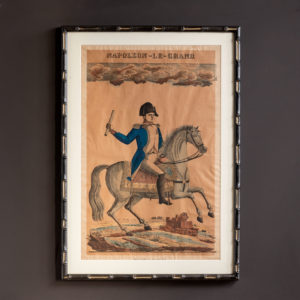
Napoleon-Le-Grand
£800Napoleon-Le-Grand
Jean-Charles Pellerin (1756 - 1836) was a French illustrator, artist, and printer. Born in Epinal, France.£800 -
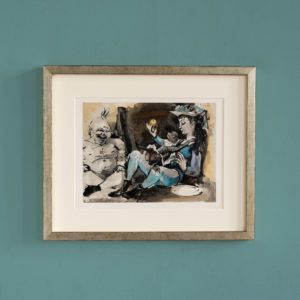
Picasso and the Human Comedy, Verve, Vol. VIII, No 29/30, 1954
£795 eachPicasso and the Human Comedy, Verve, Vol. VIII, No 29/30, 1954
Original lithograph print from Verve Vol. VIII, No 29/30 printed by the Master Printers Mourlot Frères in 1954. Framed in champagne gold with a cream mount.£795 each -

Picasso and the Human Comedy, Verve, Vol. VIII, No 29/30, 1954
£795 eachPicasso and the Human Comedy, Verve, Vol. VIII, No 29/30, 1954
Original lithograph print from Verve Vol. VIII, No 29/30 printed by the Master Printers Mourlot Frères in 1954. Framed in champagne gold with a cream mount.£795 each -

Picasso and the Human Comedy, Verve, Vol. VIII, No 29/30, 1954
£795 eachPicasso and the Human Comedy, Verve, Vol. VIII, No 29/30, 1954
Original lithograph print from Verve Vol. VIII, No 29/30 printed by the Master Printers Mourlot Frères in 1954. Framed in champagne gold with a cream mount.£795 each -

Picasso and the Human Comedy, Verve, Vol. VIII, No 29/30, 1954
£795 eachPicasso and the Human Comedy, Verve, Vol. VIII, No 29/30, 1954
Original lithograph print from Verve Vol. VIII, No 29/30 printed by the Master Printers Mourlot Frères in 1954. Framed in champagne gold with a cream mount.£795 each -

Picasso and the Human Comedy, Verve, Vol. VIII, No 29/30, 1954
£795 eachPicasso and the Human Comedy, Verve, Vol. VIII, No 29/30, 1954
Original lithograph print from Verve Vol. VIII, No 29/30 printed by the Master Printers Mourlot Frères in 1954. Framed in champagne gold with a cream mount.£795 each -

Picasso and the Human Comedy, Verve, Vol. VIII, No 29/30, 1954
£795 eachPicasso and the Human Comedy, Verve, Vol. VIII, No 29/30, 1954
Original lithograph print from Verve Vol. VIII, No 29/30 printed by the Master Printers Mourlot Frères in 1954. Framed in champagne gold with a cream mount.£795 each -

Picasso and the Human Comedy, Verve, Vol. VIII, No 29/30, 1954
£795 eachPicasso and the Human Comedy, Verve, Vol. VIII, No 29/30, 1954
Original lithograph print from Verve Vol. VIII, No 29/30 printed by the Master Printers Mourlot Frères in 1954. Framed in champagne gold with a cream mount.£795 each -

Picasso and the Human Comedy, Verve, Vol. VIII, No 29/30, 1954
£795 eachPicasso and the Human Comedy, Verve, Vol. VIII, No 29/30, 1954
Original lithograph print from Verve Vol. VIII, No 29/30 printed by the Master Printers Mourlot Frères in 1954. Framed in champagne gold with a cream mount.£795 each -

The Battle at La Hogue
£750The Battle at La Hogue
A large framed and mounted black line engraving by William Wollett afer the painting by Benjamin West showing the Anglo-Dutch naval victory at La Hogue off the coast of Normandy in 1692. " Standing in a boat at the left ... Vice Admiral George Rooke embodies heroic command with his upright posture and raised sword... Beached in the center distance is the French flagship, the Royal Sun. Actually burned and sunk a few days before this encounter, the Royal Sun is here deliberately refloated -- only to be run against the cliffs so that West might symbolize the French defeat." U.S. National Gallery of Art, Washington D.C.£750 -

Nathaniel Sparks, The Clock Tower, St. Pauls,
£750Nathaniel Sparks, The Clock Tower, St. Pauls,
Mounted and in its original frame, an original dry-point engraving by the artist and painter-etcher Nathaniel Sparks showing the Clock Tower of St Paul's Cathedral viewed from Carter Lane. The first clock was inserted into the Great West Portico of St Paul's by Smith of Derby in 1893 and is still maintained by them to this day. Signed by the artist on the plate. Presented in a black frame with a cream mount.£750 -

Our Fathers, To The Memory of the Nameless Killed and Wounded
£725 the pairOur Fathers, To The Memory of the Nameless Killed and Wounded
A set of four etchings in two frames depicting ships of war and life at sea in English history By William Wylie and accompanied by the words of Cpt. Ronald Hopwood's poem Our Fathers. William Lionel Wylie was the most distinguished marine artist of the late nineteenth and early twentieth centuries. He became almost a painter laureate to the Royal Navy, so much so that during his funeral, in a scene reminiscent of Nelson's state funeral in 1806, his body was rowed up Portsmouth Harbour in a naval cutter past battleships with dipped colours and bugles calling and quaysides lined with dockyard workers. Similarly Captain Ronald A Hopwood was described as the poet laureate of the Royal Navy by Time Magazine in 1941. His most enduring work, The Laws of the Navy, became and remains a sort of Works and Days primer for naval life, both inspiring and edifying seamen in the ways of the senior service. After the Battle of Jutland in 1916 when the press was critical of an apparent failure by the Royal Navy to achieve a clear victory against the Imperial German Navy the Times of London published The Old Ways, a poem by Hopwood and within this was a further poem, Our Fathers which was first written during the naval manoeuvres of 1913. Wyllie, we are told, was much taken with the verses and he arranged to illustrate them with the agreement of their author as a memorial of sorts to the dead (and perhaps as an apologia for the living) of the Battle of Jutland. The seaplane depicted appears to be a short type 184 used at Gallipoli where it became the first aircraft in the world to attack an enemy ship with an air-launched torpedo. The Battleship in the next image is of the King George V class and likely to be based on HMS Audacious, which Wylie had studied previously. The poem and illustrative etchings then go back in time to the navy of Elizabeth I's time. The sailing ships depicted are galleons of the type which chased the Spanish Armada out of the channel, a scene depicted at the bottom of the first print. The second framed picture depicts naval exercises and gunnery practice, with a galleon being scraped and caulked by hand on a secluded beach in the Spanish Main. It concludes with a scene of high-technology Super-Dreadnoughts of the Queen Elizabeth class - a naval nominative choice which perhaps inspires the scheme of the whole work of reflection.£725 the pair -
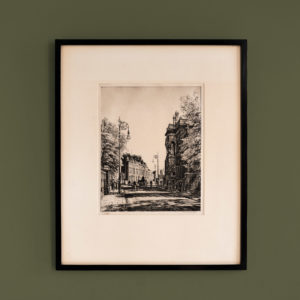
Poplar
£650Poplar
An original framed and mounted dry-point engraving by the artist engraver Frances Dodd RA showing Poplar Old Town hall on Newby Place in 1930. Hand signed in pencil by the artist.£650 -

St. James’s Church Clerkenwell
£650St. James’s Church Clerkenwell
A framed and mounted black line etching by the English artist Sir Henry Rushbury KCVO CBE RA (28 October 1889 – 5 July 1968) depicting St James's Church Clerkenwell. Signed in pencil by the artist. Clerkenwell contained a notorious slum at the turn of the 20h Century and was the setting for George Gissing's Novel, The Netherworld - "Opposite, the shapes of poverty-eaten houses and grimy workshops stood huddling in the obscurity. From near at hand came shrill voices of children chasing each other about – children playing at midnight between slum and gaol!"£650 -

Lambeth Bridge With Shipping
£650Lambeth Bridge With Shipping
Pedestrians idle on the parapet of Old Lambeth Bridge while a steam tug passes beneath the central arch towing a Thames barge. Warehouses, wharves and houses line the Westminster shore. A Framed and mounted mixed media sketch by the artist Hubert Williams showing Old Lambeth Bridge prior to it's demolition in 1928. Signed on the plate by the artist.£650 -

Admiral Lord Nelson at Copenhagen,
£650Admiral Lord Nelson at Copenhagen,
A framed mezzotint engraving of Admiral Lord Nelson at the battle of Copenhagen by Charles Turner, after John Hoppner. From the collection of Sir John Malcolm Fraser, 1st Baronet, journalist, Royal Naval captain, and vice-chairman of the Conservative Party.£650 -

St. Paul’s Cathedral from Cannon Street
£625St. Paul’s Cathedral from Cannon Street
A famed drypoint engraving of a bomb-damaged St Pauls viewed from Cannon Street dated 1942 by the War Artist Sir Henry Rushbury KCVO CBE RA (28 October 1889 – 5 July 1968). Signed and dated by the artist.£625 -

Captain Sir Christopher Cole,
£605Captain Sir Christopher Cole,
A framed portrait engraving by George H Phillips from the painting by William Owen R.A. showing the Naval Officer an statesman Captain Sir Christopher Cole.£605 -

Pair of 19th Century Traditional Chinese Figure Paintings.
£600 the pairPair of 19th Century Traditional Chinese Figure Paintings.
Chinese pith paintings came into use for painting to satisfy the increasing demand for small, inexpensive and easily transported souvenirs, following the massive growth in the China Trade in the first quarter of the nineteenth century. Because of the nature of pith and its cellular structure, the gouache used by the Chinese sat on the surface and produced a bright and even sparkling effect.£600 the pair -

Portrait Fragment by Pierre Bonnard, Verve Vol 2 / No. 5-6.
£600Portrait Fragment by Pierre Bonnard, Verve Vol 2 / No. 5-6.
The Verve Review was a purposefully luxurious. It ran from 1937 to 1960, but with only 38 editions available, due to the high degree of design and editorial work dedicated to each issue. Each edition contained unique lithographic prints, commissioned by the editor, and each cover a double-page lithograph elaborated by one of the artists contained within. It was the brainchild of its editor Stratis Eleftheriades, a Greek National who moved to Paris in the early thirties to take part in the growing Modernist movement, writing under the name of Teriade.£600 -

The Four Elements, Earth by Francisco Bores, Verve Vol. 1 / No. 1.
£600The Four Elements, Earth by Francisco Bores, Verve Vol. 1 / No. 1.
The Verve Review was a purposefully luxurious. It ran from 1937 to 1960, but with only 38 editions available, due to the high degree of design and editorial work dedicated to each issue. Each edition contained unique lithographic prints, commissioned by the editor, and each cover a double-page lithograph elaborated by one of the artists contained within. It was the brainchild of its editor Stratis Eleftheriades, a Greek National who moved to Paris in the early thirties to take part in the growing Modernist movement, writing under the name of Teriade.£600 -
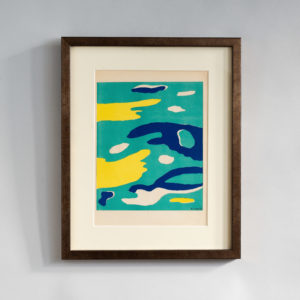
The Four Elements, Water by Fernand Leger, Verve Vol. 1 / No. 1.
£600The Four Elements, Water by Fernand Leger, Verve Vol. 1 / No. 1.
The Verve Review was a purposefully luxurious. It ran from 1937 to 1960, but with only 38 editions available, due to the high degree of design and editorial work dedicated to each issue. Each edition contained unique lithographic prints, commissioned by the editor, and each cover a double-page lithograph elaborated by one of the artists contained within. It was the brainchild of its editor Stratis Eleftheriades, a Greek National who moved to Paris in the early thirties to take part in the growing Modernist movement, writing under the name of Teriade.£600 -

Autumn by Abraham Rattner, Verve Vol. 1 / No. 3.
£600Autumn by Abraham Rattner, Verve Vol. 1 / No. 3.
The Verve Review was a purposefully luxurious. It ran from 1937 to 1960, but with only 38 editions available, due to the high degree of design and editorial work dedicated to each issue. Each edition contained unique lithographic prints, commissioned by the editor, and each cover a double-page lithograph elaborated by one of the artists contained within. It was the brainchild of its editor Stratis Eleftheriades, a Greek National who moved to Paris in the early thirties to take part in the growing Modernist movement, writing under the name of Teriade.£600 -

The Moon by André Masson, Verve Vol. 1 / No. 2.
£600The Moon by André Masson, Verve Vol. 1 / No. 2.
The Verve Review was a purposefully luxurious. It ran from 1937 to 1960, but with only 38 editions available, due to the high degree of design and editorial work dedicated to each issue. Each edition contained unique lithographic prints, commissioned by the editor, and each cover a double-page lithograph elaborated by one of the artists contained within. It was the brainchild of its editor Stratis Eleftheriades, a Greek National who moved to Paris in the early thirties to take part in the growing Modernist movement, writing under the name of Teriade.£600 -
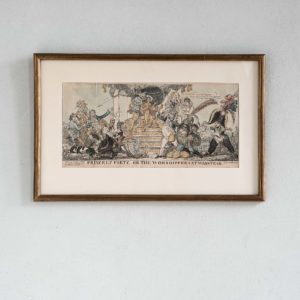
Princely Piety, or the worshippers at Wanstead,
£595Princely Piety, or the worshippers at Wanstead,
A hand-coloured etching by the caricaturist George Cruikshank depicting the wooing of a wealthy young heiress by a cast of reprobate suitors. Upon the death of her only brother James at the age of 11 in 1805 Catherine Tylney-Long became the richest commoner in England in her own right. At the tender of of 16 the 'Wiltshire Heiress' had come into a fortune of nearly £30,000,000 in today's money. This made the poor girl a prime target for every fortune hunter and indebted rake in England who wished to clear his creditors. The law as it stood in the early 19th Century had degenerated to such a degree that, under the principle of coverture, it denied a married woman any property at all in her own right while her legal existence as a feme covert was entirely subsumed in that of her husband. This left the wealthy orphan daughter of Sir James Tylney long, 7th Baronet in a difficult and precarious position, caught between the social stigma attached to unmarried womanhood and the appeals of a host of insinuating cads seeking her hand in marriage. Here Cruikshank depicts the many and assorted indigent suitors for the hand of the wealthy heiress. To the left of the dais are shown Lord Kilworth and William Wesley-Pole, later 4th Earl of Mornington a dissipated Anglo-Irish nobleman, who dueled over the courtship of Catherine. Kneeling at the foot of the steps we may also see the figure of Romeo Coates, unintentionally comic actor and 'improver' of Shakespeare included apparently 'not because of his pretensions, but his boasts and wishes'. Above him we see the fop and jobbing playwright, Sir Lumley Skeffington laying his poetic efforts at the feet of the heiress. On the right hand we see The Duke of Clarence, later William IV who by this point had debts of many hundreds of thousands of pounds holding back Baron-de-Geramb, a Spanish military adventurer and suspected Napoleonic spy who later became a Trappist monk where he used his position as procurator-general of that ancient order to defray his personal expenses. Above the Duke we see reproving the figure of Mrs Jordan, his 'common-law' wife with whom he had fathered many children at his retreat of Bushey Park. The farcical presentation of the situation belies it's tragic outcome. Perhaps cajoled by just such unkind insinuations as are repeated in this caricature Catherine would choose the worst-of-the-bunch, William Wesley-Pole, as her preferred suitor. William Wesley-Pole-Tylney-Long, as he became by Royal Licence in 1812, was an unredeemed rake and not only abused and impoverished his saintly young wife but also passed her a debilitating infection and caused her family seat at Wanstead House to be demolished and sold for salvage. After a short and unhappy marriage Catherine died at the age of only 35 after receiving a final brutal letter from her estranged husband, the contents of which apparently caused her to have some form of seizure. Frustrated in his efforts to gain custody of their son William, on whom the family fortune had devolved, William Pole Tylney-Long-Wellesley, 4th Earl of Mornington (the final name by which he was known) died in 1857 unwept, unhonoured and unsung if also unrepentant. His obituary in the Morning Star described him as "A spendthrift, a profligate, and a gambler in his youth, he became debauched in his manhood... redeemed by no single virtue, adorned by no single grace, his life gone out even without a flicker of repentance".£595 -

Black Hill, by Gordon House
£575 eachBlack Hill, by Gordon House
Gordon House was a graphic designer and abstract painter. He went to art school in Luton, then later, won a scholarship to St. Albans. During the 1950’s he spent much time in Letchworth, Welwyn and working for Imperial Chemical Industries (ICI) becoming aware of a modernist style of graphics through the design of European pharmaceutical packaging. This style was new to British eyes at the time and he went on to design the graphics for many galleries during the 1960’s. Mixing in new circles he collaborated with leading artists like Peter Blake and Richard Hamilton. He was responsible for the white on white emboss of the band’s name across the record sleeve on the Beatles White album against the wishes of Hamilton, who wanted to leave the sleeves totally blank, save for the stamp of a unique issue number. The Tate Gallery holds more than 100 of his prints and his work is also represented in many important public collections including the Arts Council, the British Council, the Victoria & Albert Museum and the M.O.M.A. in New York.£575 each -

Black Hill, Pages, by Gordon House
£575 eachBlack Hill, Pages, by Gordon House
Gordon House was a graphic designer and abstract painter. He went to art school in Luton, then later, won a scholarship to St. Albans. During the 1950’s he spent much time in Letchworth, Welwyn and working for Imperial Chemical Industries (ICI) becoming aware of a modernist style of graphics through the design of European pharmaceutical packaging. This style was new to British eyes at the time and he went on to design the graphics for many galleries during the 1960’s. Mixing in new circles he collaborated with leading artists like Peter Blake and Richard Hamilton. He was responsible for the white on white emboss of the band’s name across the record sleeve on the Beatles White album against the wishes of Hamilton, who wanted to leave the sleeves totally blank, save for the stamp of a unique issue number. The Tate Gallery holds more than 100 of his prints and his work is also represented in many important public collections including the Arts Council, the British Council, the Victoria & Albert Museum and the M.O.M.A. in New York.£575 each -

Black Hill, Rostra, by Gordon House
£575 eachBlack Hill, Rostra, by Gordon House
Gordon House was a graphic designer and abstract painter. He went to art school in Luton, then later, won a scholarship to St. Albans. During the 1950’s he spent much time in Letchworth, Welwyn and working for Imperial Chemical Industries (ICI) becoming aware of a modernist style of graphics through the design of European pharmaceutical packaging. This style was new to British eyes at the time and he went on to design the graphics for many galleries during the 1960’s. Mixing in new circles he collaborated with leading artists like Peter Blake and Richard Hamilton. He was responsible for the white on white emboss of the band’s name across the record sleeve on the Beatles White album against the wishes of Hamilton, who wanted to leave the sleeves totally blank, save for the stamp of a unique issue number. The Tate Gallery holds more than 100 of his prints and his work is also represented in many important public collections including the Arts Council, the British Council, the Victoria & Albert Museum and the M.O.M.A. in New York.£575 each -

Black Hill, Work Shop, by Gordon House
£575 eachBlack Hill, Work Shop, by Gordon House
Gordon House was a graphic designer and abstract painter. He went to art school in Luton, then later, won a scholarship to St. Albans. During the 1950’s he spent much time in Letchworth, Welwyn and working for Imperial Chemical Industries (ICI) becoming aware of a modernist style of graphics through the design of European pharmaceutical packaging. This style was new to British eyes at the time and he went on to design the graphics for many galleries during the 1960’s. Mixing in new circles he collaborated with leading artists like Peter Blake and Richard Hamilton. He was responsible for the white on white emboss of the band’s name across the record sleeve on the Beatles White album against the wishes of Hamilton, who wanted to leave the sleeves totally blank, save for the stamp of a unique issue number. The Tate Gallery holds more than 100 of his prints and his work is also represented in many important public collections including the Arts Council, the British Council, the Victoria & Albert Museum and the M.O.M.A. in New York.£575 each -
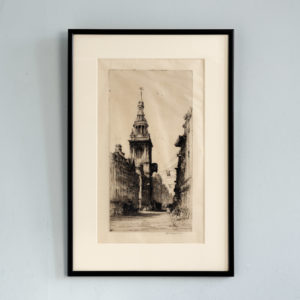
Nathaniel Sparks, St Mary-le-Bow, Cheapside,
£570Nathaniel Sparks, St Mary-le-Bow, Cheapside,
An original dry-point engraving by the artist and painter-etcher Nathaniel Sparks showing the steeple of St Mary le Bow viewed looking west up Cheapside. Signed by the artist. Presented in a cream mount and black frame.£570 -

Pablo Picasso, Lithograph based on Edouard Manet’s, Luncheon on the the Grass. c1962
£550Pablo Picasso, Lithograph based on Edouard Manet’s, Luncheon on the the Grass. c1962
From 1959-1962 Pablo Picasso and his second wife Jacqueline lived at Château de Vauvenargues near Aix-en-Provence. He spent most of his time of his time on 140 drawings and 27 paintings, lino-cuts and cardboard models all on the theme of Manet’s, Le Déjeuner sur l’herbe. Manet's original painting from 1862 showing a nude woman sitting between two fully clothed men was a scandal for the time.£550 -

Buildings & Boats
£550Buildings & Boats
A framed and mounted black line etching by the artist-engraver Norman Jones RWS RE RSMA, showing a riverside wharf scene in the Lower Pool of the River Thames, possibly corresponding to the river frontage of Narrow Street, Limehouse. Signed in pencil by the artist.£550 -
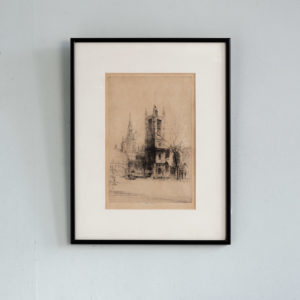
Frederick Farrell, St. Margarets Church, Westminster,
£550Frederick Farrell, St. Margarets Church, Westminster,
A framed and mounted original etching by Frederick Arthur Farrell depicting St Margaret's Church Westminster from across Parliament Square. Hand signed by the artist in pencil.£550 -

Charles Watson, Chelsea
£550Charles Watson, Chelsea
A framed and mounted etching by the English artist Charles Watson (1846-1927) depicting the foreshore at Chelsea with two barges at low tide. In the distance is shown the tower of Chelsea Old Church and a part of Old Battersea Bridge, replaced in 1890. The vantage is from close to the current site of the Chelsea Yacht and Boat Yard. Signed on the plate.£550 -

An Almanac of Twelve Sports by William Nicholson,
£550An Almanac of Twelve Sports by William Nicholson,
The Almanac was first published by Heinemann in London for Christmas 1897 with a calendar for the year 1898. Sir William Nicholson was a late 19th Century painter and print-maker. His experiments with woodcut printing encouraged the development of his distinctive pictorial style. After making his name with a series of twelve portraits of public figures (which won a gold medal at the 1900 Exposition Universelle in Paris) he moved on to produce this Almanac of twelve sports for his new publisher, Heinemann. The accompanying text was provided by the poet Rudyard Kipling. Kipling was not an enthusiastic sportsman, in fact he derided 'flannelled fools at the wicket' and 'muddied oafs at the goal' in his poem The Islanders however, after sitting for a Nicholson portrait, he agreed to provide a set of short poems to match the depicted sports. Kipling adopted a concise and suggestive style for the poems, harking back to his Departmental ditties of the 1880's. One verse at least, the draft couplet for the coaching party depicted in August, was considered too suggestive by half and was excised by Heinemann as unsuitable for the family audience he had in mind:'Youth on the box and liquor in the boot / My Lord drives out with my Lord's prostitute.'
£550 -
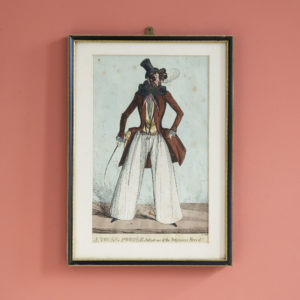
‘A Young Poodle, but not one of the Sagacious Breed’
£520‘A Young Poodle, but not one of the Sagacious Breed’
Caricaturist, presumably of Irish background, but undocumented. Responsible for a small number of plates in a distinctive hand. Unclear whether he etched them all or only designed them. Never a publisher. Worked for P.Roberts and J.Aitken. Many unsigned prints by both men may well be by him.£520 -
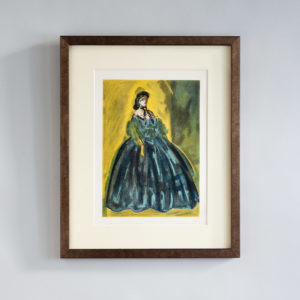
Portraits Part II by Constantin Guys, Verve Vol 2 / No. 5-6.
£500Portraits Part II by Constantin Guys, Verve Vol 2 / No. 5-6.
The Verve Review was a purposefully luxurious. It ran from 1937 to 1960, but with only 38 editions available, due to the high degree of design and editorial work dedicated to each issue. Each edition contained unique lithographic prints, commissioned by the editor, and each cover a double-page lithograph elaborated by one of the artists contained within. It was the brainchild of its editor Stratis Eleftheriades, a Greek National who moved to Paris in the early thirties to take part in the growing Modernist movement, writing under the name of Teriade.£500 -

Portraits Part I by Constantin Guys, Verve Vol 2 / No. 5-6.
£500Portraits Part I by Constantin Guys, Verve Vol 2 / No. 5-6.
The Verve Review was a purposefully luxurious. It ran from 1937 to 1960, but with only 38 editions available, due to the high degree of design and editorial work dedicated to each issue. Each edition contained unique lithographic prints, commissioned by the editor, and each cover a double-page lithograph elaborated by one of the artists contained within. It was the brainchild of its editor Stratis Eleftheriades, a Greek National who moved to Paris in the early thirties to take part in the growing Modernist movement, writing under the name of Teriade.£500 -

Joan Miró, Lithographie originale
£500Joan Miró, Lithographie originale
Joan Miró produced nearly 1,800 original lithographs and prints at the Maeght studio. He composed his score, invented his alphabet, scattered his symbols across the white page of his writing, close to graffiti. Everything was free, released, aerial, penetrated with interior light. He celebrated marriages between all techniques. Nothing was ever excessive or gratuitous. His creation cut to the essential. Miró created his own language. Dots, lines, scratches, graffiti, writing, mysterious anthropomorphic figures swimming or flying through infinite territory, fed by sparks. The power of black, awestruck colors… And the paper always defended its whiteness. Miró was about drawing above all else. His energy burst on to the sheet.£500 -

Joan Miró, Lithographie originale
£500Joan Miró, Lithographie originale
Joan Miró produced nearly 1,800 original lithographs and prints at the Maeght studio. He composed his score, invented his alphabet, scattered his symbols across the white page of his writing, close to graffiti. Everything was free, released, aerial, penetrated with interior light. He celebrated marriages between all techniques. Nothing was ever excessive or gratuitous. His creation cut to the essential. Miró created his own language. Dots, lines, scratches, graffiti, writing, mysterious anthropomorphic figures swimming or flying through infinite territory, fed by sparks. The power of black, awestruck colors… And the paper always defended its whiteness. Miró was about drawing above all else. His energy burst on to the sheet.£500 -

Joan Miró, Lithographie originale
£500Joan Miró, Lithographie originale
Joan Miró produced nearly 1,800 original lithographs and prints at the Maeght studio. He composed his score, invented his alphabet, scattered his symbols across the white page of his writing, close to graffiti. Everything was free, released, aerial, penetrated with interior light. He celebrated marriages between all techniques. Nothing was ever excessive or gratuitous. His creation cut to the essential. Miró created his own language. Dots, lines, scratches, graffiti, writing, mysterious anthropomorphic figures swimming or flying through infinite territory, fed by sparks. The power of black, awestruck colors… And the paper always defended its whiteness. Miró was about drawing above all else. His energy burst on to the sheet.£500 -

Joan Miró, Lithographie originale
£500Joan Miró, Lithographie originale
Joan Miró produced nearly 1,800 original lithographs and prints at the Maeght studio. He composed his score, invented his alphabet, scattered his symbols across the white page of his writing, close to graffiti. Everything was free, released, aerial, penetrated with interior light. He celebrated marriages between all techniques. Nothing was ever excessive or gratuitous. His creation cut to the essential. Miró created his own language. Dots, lines, scratches, graffiti, writing, mysterious anthropomorphic figures swimming or flying through infinite territory, fed by sparks. The power of black, awestruck colors… And the paper always defended its whiteness. Miró was about drawing above all else. His energy burst on to the sheet.£500 -

Joan Miró, Lithographie originale
£500Joan Miró, Lithographie originale
Joan Miró produced nearly 1,800 original lithographs and prints at the Maeght studio. He composed his score, invented his alphabet, scattered his symbols across the white page of his writing, close to graffiti. Everything was free, released, aerial, penetrated with interior light. He celebrated marriages between all techniques. Nothing was ever excessive or gratuitous. His creation cut to the essential. Miró created his own language. Dots, lines, scratches, graffiti, writing, mysterious anthropomorphic figures swimming or flying through infinite territory, fed by sparks. The power of black, awestruck colors… And the paper always defended its whiteness. Miró was about drawing above all else. His energy burst on to the sheet.£500 -

Joan Miró, Lithographie originale
£500Joan Miró, Lithographie originale
Joan Miró produced nearly 1,800 original lithographs and prints at the Maeght studio. He composed his score, invented his alphabet, scattered his symbols across the white page of his writing, close to graffiti. Everything was free, released, aerial, penetrated with interior light. He celebrated marriages between all techniques. Nothing was ever excessive or gratuitous. His creation cut to the essential. Miró created his own language. Dots, lines, scratches, graffiti, writing, mysterious anthropomorphic figures swimming or flying through infinite territory, fed by sparks. The power of black, awestruck colors… And the paper always defended its whiteness. Miró was about drawing above all else. His energy burst on to the sheet.£500 -

Joan Miró, Lithographie originale
£500Joan Miró, Lithographie originale
Joan Miró produced nearly 1,800 original lithographs and prints at the Maeght studio. He composed his score, invented his alphabet, scattered his symbols across the white page of his writing, close to graffiti. Everything was free, released, aerial, penetrated with interior light. He celebrated marriages between all techniques. Nothing was ever excessive or gratuitous. His creation cut to the essential. Miró created his own language. Dots, lines, scratches, graffiti, writing, mysterious anthropomorphic figures swimming or flying through infinite territory, fed by sparks. The power of black, awestruck colors… And the paper always defended its whiteness. Miró was about drawing above all else. His energy burst on to the sheet.£500 -

Joan Miró, Lithographie originale
£500Joan Miró, Lithographie originale
Joan Miró produced nearly 1,800 original lithographs and prints at the Maeght studio. He composed his score, invented his alphabet, scattered his symbols across the white page of his writing, close to graffiti. Everything was free, released, aerial, penetrated with interior light. He celebrated marriages between all techniques. Nothing was ever excessive or gratuitous. His creation cut to the essential. Miró created his own language. Dots, lines, scratches, graffiti, writing, mysterious anthropomorphic figures swimming or flying through infinite territory, fed by sparks. The power of black, awestruck colors… And the paper always defended its whiteness. Miró was about drawing above all else. His energy burst on to the sheet.£500 -

Joan Miró, Lithographie originale
£500Joan Miró, Lithographie originale
Joan Miró produced nearly 1,800 original lithographs and prints at the Maeght studio. He composed his score, invented his alphabet, scattered his symbols across the white page of his writing, close to graffiti. Everything was free, released, aerial, penetrated with interior light. He celebrated marriages between all techniques. Nothing was ever excessive or gratuitous. His creation cut to the essential. Miró created his own language. Dots, lines, scratches, graffiti, writing, mysterious anthropomorphic figures swimming or flying through infinite territory, fed by sparks. The power of black, awestruck colors… And the paper always defended its whiteness. Miró was about drawing above all else. His energy burst on to the sheet.£500 -
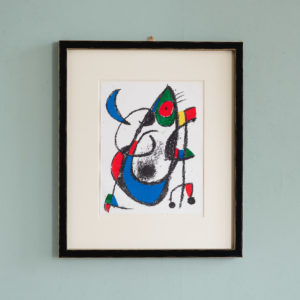
Joan Miró, Lithographie originale
£500Joan Miró, Lithographie originale
Joan Miró produced nearly 1,800 original lithographs and prints at the Maeght studio. He composed his score, invented his alphabet, scattered his symbols across the white page of his writing, close to graffiti. Everything was free, released, aerial, penetrated with interior light. He celebrated marriages between all techniques. Nothing was ever excessive or gratuitous. His creation cut to the essential. Miró created his own language. Dots, lines, scratches, graffiti, writing, mysterious anthropomorphic figures swimming or flying through infinite territory, fed by sparks. The power of black, awestruck colors… And the paper always defended its whiteness. Miró was about drawing above all else. His energy burst on to the sheet.£500 -

The Triumphal Arches, Mr. Handel’s Statue & c. in the South Walk of Vauxhall Gardens
£495The Triumphal Arches, Mr. Handel’s Statue & c. in the South Walk of Vauxhall Gardens
Based on the work by Samuel Wale and engraved by Benjamin Cole in 1752. Mounted and presented in a Hogarth style frame.£495 -
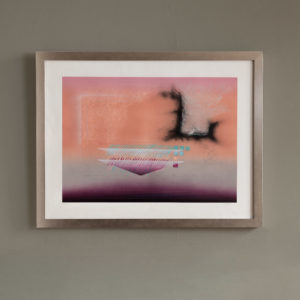
“Progress IV” artists screenprint by Anthony Benjamin (1931 – 2002)
£480“Progress IV” artists screenprint by Anthony Benjamin (1931 – 2002)
Anthony Benjamin (29 March 1931 – 17 February 2002) FRSA, RE was an English painter, sculptor and printmaker. Benjamin was a fellow of the Royal Society of Arts (FRSA) and a member of the Royal Society of Painter-Printmakers (RE)£480 -

The Grand South Walk in Vaux-Hall Gardens, with the Triumphal Arches, Mr Handels Statue, &c.
£450 -
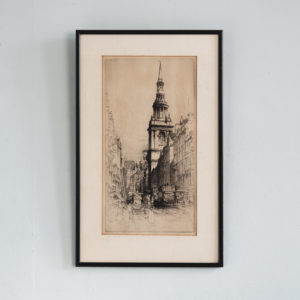
Sydney R Jones, St. Mary le Bow, Cheapside,
£450Sydney R Jones, St. Mary le Bow, Cheapside,
A mounted, framed and signed etching by the English artist Sydney R Jones (1881-1966) depicting the church of St Mary le Bow on Cheapside, London. Hand signed by the artist in pencil, bottom left, with a note that it is the '5th state' of the etching.£450 -

Nathaniel Sparks, Westminster from the Horseguards,
£450Nathaniel Sparks, Westminster from the Horseguards,
Mounted and in its original frame, an original dry-point engraving by the artist and painter-etcher Nathaniel Sparks showing the North Door and Lady Chapel of Westminster Abbey viewed across Parliament Square. Signed proof impression from the only edition.£450 -

Nathaniel Sparks, St. Botolphs Church,
£450Nathaniel Sparks, St. Botolphs Church,
Mounted and in its original frame, an original dry-point engraving by the artist and painter-etcher Nathaniel Sparks showing St Botolph's church on Bishopsgate in the City of London. The corner building in the middle foreground is the White Hart Inn which had existed as a hostelry continuously on the site since 1377 until it was closed for commercial redevelopment in 2014. Signed by the artist.£450 -

Nathaniel Sparks, St. James Palace,
£450Nathaniel Sparks, St. James Palace,
Mounted and in its original frame, an original dry-point engraving by the artist and painter-etcher Nathaniel Sparks showing the north gatehouse of St James's Palace viewed across Pall Mall from the east side of St James's Street. Signed by the artist.£450 -

Nathaniel Sparks, Waterloo Bridge,
£450Nathaniel Sparks, Waterloo Bridge,
Mounted and in its original frame, an original dry-point engraving by the artist and painter-etcher Nathaniel Sparks showing the northernmost arch of Old Waterloo Bridge with Charing Cross and Westminster bridges beyond and the Palace of Westminster in the distance. Signed by the artist.£450 -

Old Maid on a Journey,
£450Old Maid on a Journey,
An original framed hand-coloured etching and engraving by caricaturist James Gillray. The corpulent figure of the independent polymath, antiquarian and collector Miss Sarah Sophia Banks is depicted being shown into the best bedroom of an Inn followed by a grotesque retinue of gurning servants carrying her assorted baggage. Miss Banks was a prolific collector of printed emphemera including broadsheets, newspaper clippings, visiting cards, caricatures, advertisements and playbills as well as being a leading numismatist of her day. Her great library of volumes on ancient coins as well as her capacious collection of the coins themselves was gifted to the nation upon her death and are now spread over the Royal Mint, The British Library and British Museum. One of the 18th Century's brilliant but unacknowledged women, Sarah Banks was the sister of the famous botanist Joseph Banks who sailed with Captain Cook to New South Wales. According to recent scholarship as well as editing her brother's manuscripts she often conversed with him on their subjects and many of her ideas were incorporated into his writings. Perhaps puzzlingly, given the warm and close friendship which was said to exist between Gillray and his wealthy female patron, Miss Banks is depicted as a obscenely fat and ugly. One can only speculate on the nature of the comedy and manners of the time (not to mention the sense of humour of the subject) when interpreting the comic effect of this print.£450 -

Sir Henry Irving
£450 -

The Works of New London Bridge by Edward William Cooke RA,
£450The Works of New London Bridge by Edward William Cooke RA,
A hand-coloured engraving by George Cooke of a drawing by his son Edward William Cooke RA, from 'The Works of New London Bridge'. In 1800 it was first proposed that the inconvenient medieval bulk of old London bridge should be removed to ease traffic on the Thames and a competition was held to design a replacement. In 1824, the plans of the engineer Sir John Rennie were accepted and a site was chosen 180 feet west of the old bridge. On June 15, 1825, the Lord Mayor of London, John Garratt, laid the first block of Dartmoor granite in the presence of the Duke of York. For a short time Londoners were able to view both the old bridge and the new side-by-side. It was to be a structure of 5 arches, over 928 feet long and 49 feet wide. When the new bridge was finished and opened by King William and Queen Adelaide in 1831, traffic switched to the huge new structure and the demolition commenced on the old bridge. Edward William Cooke (1811 - 1880) was a draughtsman, illustrator, wood engraver, etcher and painter of rural and coastal scenes in oil and watercolour. In this print Cooke shows new London bridge in the middle stages of construction with the forms for the arches still in place. On the far bank of the Thames the viewer can see the Fishmongers Hall, the steeple of St Magnus the Matryr church and The Monument.£450 -

Hogarth, The Four Times of the Day
£450 the setHogarth, The Four Times of the Day
Set of four prints after William Hogarth, showing the four times of the day during different seasons of the year. Printers crease on the noon plate, published c 1805 by Thomas Cook, with old hand-colour. Framed£450 the set -

The Stocks Market,
£425The Stocks Market,
A mounted and gilt framed engracing depicting the Stocks Market in the City of London by Henry Fletcher after the painting by Joseph Nicholls. The Stocks Market existed between 1282 and 1737 on the current site of the Mansion House and has given it's name to the Bourses of the English speaking world. The statue, of Charles II trampling Oliver Cromwell underoot was the subject of a satirical verse from the pen of Andrew Marvell: "But a market, as some say, doth fit the King well, Who the Parliament too — and revenue doth sell; And others, to make the similitude hold. Say his Majesty too — is oft purchased and sold."£425 -

Tenjin Festival (天神祭)
£420Tenjin Festival (天神祭)
Born in Kobe 1923, Yuzaburo started studying woodblock print making with his father when he was eight years old. At the age of nineteen, his skill was such that he exhibited at the 11th Nihon Hanga Kyōkai (Japan Print Association) exhibition, winning a first prize, but it was not until he graduated from Kwansei Gakuin University in 1947, an education that was interrupted by the 1942 wartime Student Mobilization Order., that he became a full-time print maker. After the death of his father in 1965, Yūzaburō was to go on to become a leader in the creative print genre (sosaku hanga) in the Kansai region. was a member of Japan Print Association and a member of Kokuga Association£420 -

An Alphabet by William Nicholson, A was an Artist,
£400 eachAn Alphabet by William Nicholson, A was an Artist,
Nicholson was recommended by his friend, James McNeil Whistler to the publishers Heinemann as an original and expert wood-cut artist. The relationship with the publisher was highly successful, establishing Nicholson’s reputation as an illustrator. Between 1897 and 1900 he illustrated five works: An Alphabet, An Almanac of Twelve Sports, Twelve Portraits, London Types, and The Square Book of Animals.£400 each -
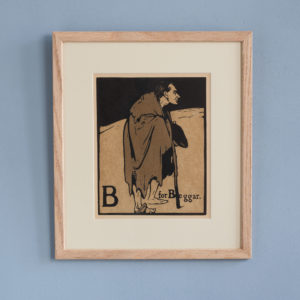
An Alphabet by William Nicholson, B for Beggar,
£400 eachAn Alphabet by William Nicholson, B for Beggar,
Nicholson was recommended by his friend, James McNeil Whistler to the publishers Heinemann as an original and expert wood-cut artist. The relationship with the publisher was highly successful, establishing Nicholson’s reputation as an illustrator. Between 1897 and 1900 he illustrated five works: An Alphabet, An Almanac of Twelve Sports, Twelve Portraits, London Types, and The Square Book of Animals.£400 each -

An Alphabet by William Nicholson, C is for Countess,
£400 eachAn Alphabet by William Nicholson, C is for Countess,
Nicholson was recommended by his friend, James McNeil Whistler to the publishers Heinemann as an original and expert wood-cut artist. The relationship with the publisher was highly successful, establishing Nicholson’s reputation as an illustrator. Between 1897 and 1900 he illustrated five works: An Alphabet, An Almanac of Twelve Sports, Twelve Portraits, London Types, and The Square Book of Animals.£400 each -

An Alphabet by William Nicholson, D is for Dandy,
£400 eachAn Alphabet by William Nicholson, D is for Dandy,
Nicholson was recommended by his friend, James McNeil Whistler to the publishers Heinemann as an original and expert wood-cut artist. The relationship with the publisher was highly successful, establishing Nicholson’s reputation as an illustrator. Between 1897 and 1900 he illustrated five works: An Alphabet, An Almanac of Twelve Sports, Twelve Portraits, London Types, and The Square Book of Animals.£400 each -

An Alphabet by William Nicholson, F is for Flower Girl,
£400 eachAn Alphabet by William Nicholson, F is for Flower Girl,
Nicholson was recommended by his friend, James McNeil Whistler to the publishers Heinemann as an original and expert wood-cut artist. The relationship with the publisher was highly successful, establishing Nicholson’s reputation as an illustrator. Between 1897 and 1900 he illustrated five works: An Alphabet, An Almanac of Twelve Sports, Twelve Portraits, London Types, and The Square Book of Animals.£400 each -

An Alphabet by William Nicholson, G for Gentleman,
£400 eachAn Alphabet by William Nicholson, G for Gentleman,
Nicholson was recommended by his friend, James McNeil Whistler to the publishers Heinemann as an original and expert wood-cut artist. The relationship with the publisher was highly successful, establishing Nicholson’s reputation as an illustrator. Between 1897 and 1900 he illustrated five works: An Alphabet, An Almanac of Twelve Sports, Twelve Portraits, London Types, and The Square Book of Animals.£400 each
Featured Items
-

Autumn by Abraham Rattner, Verve Vol. 1 / No. 3.
£600Autumn by Abraham Rattner, Verve Vol. 1 / No. 3.
The Verve Review was a purposefully luxurious. It ran from 1937 to 1960, but with only 38 editions available, due to the high degree of design and editorial work dedicated to each issue. Each edition contained unique lithographic prints, commissioned by the editor, and each cover a double-page lithograph elaborated by one of the artists contained within. It was the brainchild of its editor Stratis Eleftheriades, a Greek National who moved to Paris in the early thirties to take part in the growing Modernist movement, writing under the name of Teriade.£600 -

Stars by Wassily Kandinsky, Verve Vol. 1 / No. 2.
£800Stars by Wassily Kandinsky, Verve Vol. 1 / No. 2.
The Verve Review was a purposefully luxurious. It ran from 1937 to 1960, but with only 38 editions available, due to the high degree of design and editorial work dedicated to each issue. Each edition contained unique lithographic prints, commissioned by the editor, and each cover a double-page lithograph elaborated by one of the artists contained within. It was the brainchild of its editor Stratis Eleftheriades, a Greek National who moved to Paris in the early thirties to take part in the growing Modernist movement, writing under the name of Teriade.£800 -

Portrait Fragment by Pierre Bonnard, Verve Vol 2 / No. 5-6.
£600Portrait Fragment by Pierre Bonnard, Verve Vol 2 / No. 5-6.
The Verve Review was a purposefully luxurious. It ran from 1937 to 1960, but with only 38 editions available, due to the high degree of design and editorial work dedicated to each issue. Each edition contained unique lithographic prints, commissioned by the editor, and each cover a double-page lithograph elaborated by one of the artists contained within. It was the brainchild of its editor Stratis Eleftheriades, a Greek National who moved to Paris in the early thirties to take part in the growing Modernist movement, writing under the name of Teriade.£600 -

Portrait by Andre Derain, Verve Vol 2 / No. 5-6.
£800Portrait by Andre Derain, Verve Vol 2 / No. 5-6.
The Verve Review was a purposefully luxurious. It ran from 1937 to 1960, but with only 38 editions available, due to the high degree of design and editorial work dedicated to each issue. Each edition contained unique lithographic prints, commissioned by the editor, and each cover a double-page lithograph elaborated by one of the artists contained within. It was the brainchild of its editor Stratis Eleftheriades, a Greek National who moved to Paris in the early thirties to take part in the growing Modernist movement, writing under the name of Teriade.£800

